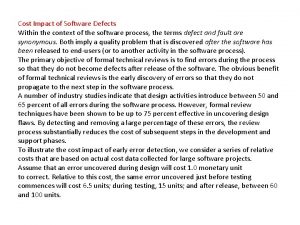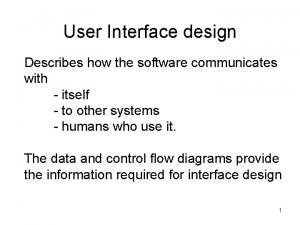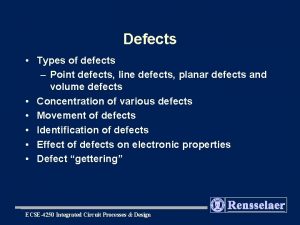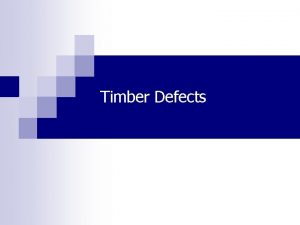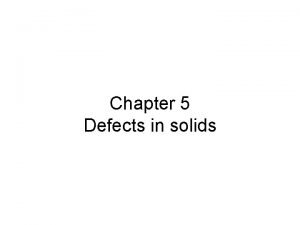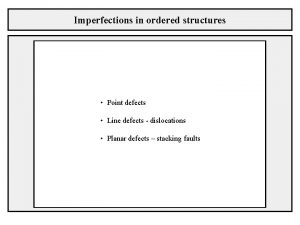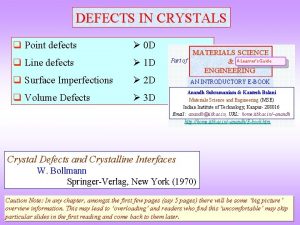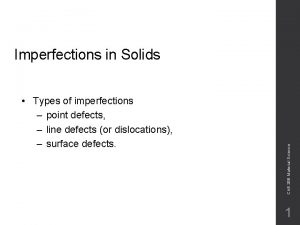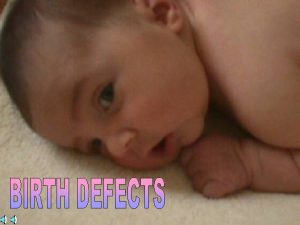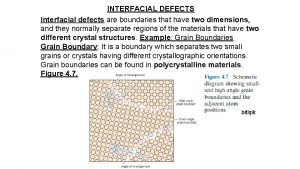Cost Impact of Software Defects Within the context
















- Slides: 16

Cost Impact of Software Defects Within the context of the software process, the terms defect and fault are synonymous. Both imply a quality problem that is discovered after the software has been released to end-users (or to another activity in the software process). The primary objective of formal technical reviews is to find errors during the process so that they do not become defects after release of the software. The obvious benefit of formal technical reviews is the early discovery of errors so that they do not propagate to the next step in the software process. A number of industry studies indicate that design activities introduce between 50 and 65 percent of all errors during the software process. However, formal review techniques have been shown to be up to 75 percent effective in uncovering design flaws. By detecting and removing a large percentage of these errors, the review process substantially reduces the cost of subsequent steps in the development and support phases. To illustrate the cost impact of early error detection, we consider a series of relative costs that are based on actual cost data collected for large software projects. Assume that an error uncovered during design will cost 1. 0 monetary unit to correct. Relative to this cost, the same error uncovered just before testing commences will cost 6. 5 units; during testing, 15 units; and after release, between 60 and 100 units.

Defect Amplification and Removal A defect amplification model can be used to illustrate the generation and detection of errors during the preliminary design, detail design, and coding steps of the software engineering process. The model is illustrated schematically in Figure below. During the step, errors may be mistakenly generated. Review may fail to uncover newly generated errors and errors from previous steps, resulting in some number of errors that are passed through. In some cases, errors passed through from previous steps are amplified (amplification factor, x) by current work. The box subdivisions represent each of these characteristics and the percent of efficiency for detecting errors, a function of the thoroughness of the review. Development step Defects Errors from previous Steps Errors passed through Amplified errors 1 : x Newly generated errors Detection Percent efficiency for error detection Errors passed to next step

Figure A illustrates a hypothetical example of defect amplification for a software development process in which no reviews are conducted. Referring to the figure, each test step is assumed to uncover and correct 50 percent of all incoming errors without introducing any new errors (an optimistic assumption). Ten preliminary design defects are amplified to 94 errors before testing commences. Twelve latent errors are released to the field. Figure B considers the same conditions except that design and code reviews are conducted as part of each development step. In this case, ten initial preliminary design errors are amplified to 24 errors before testing commences. Only three latent errors exist. Recalling the relative costs associated with the discovery and correction of errors, overall cost (with and without review for our hypothetical example) can be established. The number of errors uncovered during each of the steps noted in Figures A and B is multiplied by the cost to remove an error (1. 5 cost units for design, 6. 5 cost units before test, 15 cost units during test, and 67 cost units after release). Using these data, the total cost for development and maintenance when reviews are conducted is 783 cost units. When no reviews are conducted, total cost is 2177 units—nearly three times more costly.

Defect amplification, no reviews (Fig A)

Defect amplification, reviews conducted (Fig B)

Effectiveness of review Defect Amplification and Removal

FORMAL TECHNICAL REVIEWS A formal technical review is a software quality assurance activity performed by software engineers (and others). The objectives of the FTR are (1) to uncover errors in function, logic, or implementation for any representation of the software; (2) to verify that the software under review meets its requirements; (3) to ensure that the software has been represented according to predefined standards; (4) to achieve software that is developed in a uniform manner; and (5) to make projects more manageable. In addition, the FTR serves as a training ground, enabling junior engineers to observe different approaches to software analysis, design, and implementation. The FTR also serves to promote backup and continuity because a number of people become familiar with parts of the software that they may not have otherwise seen. The FTR is actually a class of reviews that includes walkthroughs, inspections, round-robin reviews and other small group technical assessments of software. Each FTR is conducted as a meeting and will be successful only if it is properly planned, controlled, and attended. In the sections that follow, guidelines similar to those for a walkthrough, are presented as a representative formal technical review.

The Review Meeting Regardless of the FTR format that is chosen, every review meeting should abide by the following constraints: • Between three and five people (typically) should be involved in the review. • Advance preparation should occur but should require no more than two hours of work for each person. • The duration of the review meeting should be less than two hours. Given these constraints, it should be obvious that an FTR focuses on a specific (and small) part of the overall software. For example, rather than attempting to review an entire design, walkthroughs are conducted for each component or small group of components. By narrowing focus, the FTR has a higher likelihood of uncovering errors. The focus of the FTR is on a work product (e. g. , a portion of a requirements specification, a detailed component design, a source code listing for a component). The individual who has developed the work product—the producer—informs the project leader that the work product is complete and that a review is required. The project leader contacts a review leader, who evaluates the product for readiness, generates copies of product materials, and distributes them to two or three reviewers for advance preparation. Each reviewer is expected to spend between one and two hours reviewing the product, making notes, and otherwise becoming familiar with the work.

Concurrently, the review leader also reviews the product and establishes an agenda for the review meeting, which is typically scheduled for the next day. The review meeting is attended by the review leader, all reviewers, and the producer. One of the reviewers takes on the role of the recorder; that is, the individual who records (in writing) all important issues raised during the review. The FTR begins with an introduction of the agenda and a brief introduction by the producer. The producer then proceeds to "walk through" the work product, explaining the material, while reviewers raise issues based on their advance preparation. When valid problems or errors are discovered, the recorder notes each. At the end of the review, all attendees of the FTR must decide whether to (1) accept the product without further modification, (2) reject the product due to severe errors (once corrected, another review must be performed), or (3) accept the product provisionally (minor errors have been encountered and must be corrected, but no additional review will be required). The decision made, all FTR attendees complete a sign-off, indicating their participation in the review and their concurrence with the review team's findings.

Review reporting and record keeping During the FTR, a reviewer (the recorder) actively records all issues that have been raised. These are summarized at the end of the review meeting and a review issues list is produced. In addition, a formal technical review summary report is completed. A review summary report answers three questions: 1. What was reviewed? 2. Who reviewed it? 3. What were the findings and conclusions? The review summary report is a single page form (with possible attachments). It becomes part of the project historical record and may be distributed to the project leader and other interested parties. The review issues list serves two purposes: (1) to identify problem areas within the product and (2) to serve as an action item checklist that guides the producer as corrections are made. An issues list is normally attached to the summary report. It is important to establish a follow-up procedure to ensure that items on the issues list have been properly corrected.

Review Guidelines for the conduct of formal technical reviews must be established in advance, distributed to all reviewers, agreed upon, and then followed. A review that is uncontrolled can often be worse that no review at all. The following represents a minimum set of guidelines formal technical reviews: 1. Review the product, not the producer. An FTR involves people and egos. Conducted properly, the FTR should leave all participants with a warm feeling of accomplishment. Conducted improperly, the FTR can take on the aura of an inquisition. Errors should be pointed out gently; the tone of the meeting should be loose and constructive; the intent should not be to embarrass or belittle. The review leader should conduct the review meeting to ensure that the proper tone and attitude are maintained and should immediately halt a review that has gotten out of control 2. Set an agenda and maintain it. One of the key maladies of meetings of all types is drift. An FTR must be kept on track and on schedule. The review leader is chartered with the responsibility for maintaining the meeting schedule and should not be afraid to nudge people when drift sets in. .

3. Limit debate and rebuttal. When an issue is raised by a reviewer, there may not be universal agreement on its impact. Rather than spending time debating the question, the issue should be recorded for further discussion off-line. 4. Enunciate problem areas, but don't attempt to solve every problem noted. A review is not a problem-solving session. The solution of a problem can often be accomplished by the producer alone or with the help of only one other individual. Problem solving should be postponed until after the review meeting. 5. Take written notes. It is sometimes a good idea for the recorder to make notes on a wall board, so that wording and priorities can be assessed by other reviewers as information is recorded. 6. Limit the number of participants and insist upon advance preparation. Two heads are better than one, but 14 are not necessarily better than 4. Keep the number of people involved to the necessary minimum. However, all review team members must prepare in advance. Written comments should be solicited by the review leader (providing an indication that the reviewer has reviewed the material).

7. Develop a checklist for each product that is likely to be reviewed. A checklist helps the review leader to structure the FTR meeting and helps each reviewer to focus on important issues. Checklists should be developed for analysis, design, code, and even test documents. 8. Allocate resources and schedule time for FTRs. For reviews to be effective, they should be scheduled as a task during the software engineering process. In addition, time should be scheduled for the inevitable modifications that will occur as the result of an FTR. 9. Conduct meaningful training for all reviewers. To be effective all review participants should receive some formal training. The training should stress both process-related issues and the human psychological side of reviews. Freedman and Weinberg estimate a one-month learning curve for every 20 people who are to participate effectively in reviews. 10. Review your early reviews. Debriefing can be beneficial in uncovering problems with the review process itself. The very first product to be reviewed should be the review guidelines themselves

FORMAL APPROACHES TO SQA In the preceding sections, we have argued that software quality is everyone's job; that it can be achieved through competent analysis, design, coding, and testing, as well as through the application of formal technical reviews, a multitiered testing strategy, better control of software work products and the changes made to them, and the application of accepted software engineering standards. In addition, quality can be defined in terms of a broad array of quality factors and measured (indirectly) using a variety of indices and metrics. Over the past two decades, a small, segment of the software engineering community has argued that a more formal approach to software quality assurance is required. It can be argued that a computer program is a mathematical object. An accurate syntax and semantics can be defined for every programming language, and work is underway to develop a similarly rigorous approach to the specification of software requirements. If the requirements model (specification) and the programming language can be represented in a precise manner, it should be possible to apply mathematic proof of correctness to demonstrate that a program conforms exactly to its specifications. Attempts to prove programs correct are not new. Dijkstra and Linger, Mills, and Witt , among others, advocated proofs of program correctness and tied these to the use of structured programming concepts.

STATISTICAL SOFTWARE QUALITY ASSURANCE Statistical quality assurance reflects a growing trend throughout industry to become more quantitative about quality. For software, statistical quality assurance implies the following steps: 1. Information about software defects is collected and categorized. 2. An attempt is made to trace each defect to its underlying cause (e. g. , nonconformance to specifications, design error, violation of standards, poor communication with the customer). 3. Using the Pareto principle (80 percent of the defects can be traced to 20 percent of all possible causes), isolate the 20 percent (the "vital few"). 4. Once the vital few causes have been identified, move to correct the problems that have caused the defects.

This relatively simple concept represents an important step towards the creation of an adaptive software engineering process in which changes are made to improve those elements of the process that introduce error. To illustrate this, assume that a software engineering organization collects information on defects for a period of one year. Some of the defects are uncovered as software is being developed. Others are encountered after the software has been released to its end-users. Although hundreds of different errors are uncovered, all can be tracked to one (or more) of the following causes: • incomplete or invalid specifications (IES) • misinterpretation of customer communication (MCC) • intentional deviation from specifications (IDS) • violation of programming standards (VPS) • error in data representation (EDR) • inconsistent component interface (ICI) • error in design logic (EDL) • incomplete or erroneous testing (IET) • inaccurate or incomplete documentation (IID) • error in programming language translation of design (PLT) • ambiguous or inconsistent human/computer interface (HCI) • miscellaneous (MIS)
 Cost impact of software defects
Cost impact of software defects High context vs low context culture ppt
High context vs low context culture ppt Communicating across generational differences
Communicating across generational differences Deictic expressions
Deictic expressions Contoh high context culture
Contoh high context culture Impactcad
Impactcad Tracking
Tracking Describes how a software communicates within itself.
Describes how a software communicates within itself. Integrating metrics within the software process
Integrating metrics within the software process Cost accumulation and cost assignment
Cost accumulation and cost assignment Cost accumulation and cost assignment
Cost accumulation and cost assignment Manufacturing cost vs non manufacturing cost
Manufacturing cost vs non manufacturing cost Job costing and process costing
Job costing and process costing Flotation cost in cost of equity
Flotation cost in cost of equity Commited cost
Commited cost Cost accumulation and cost assignment
Cost accumulation and cost assignment Manufacturing cost vs non manufacturing cost
Manufacturing cost vs non manufacturing cost
